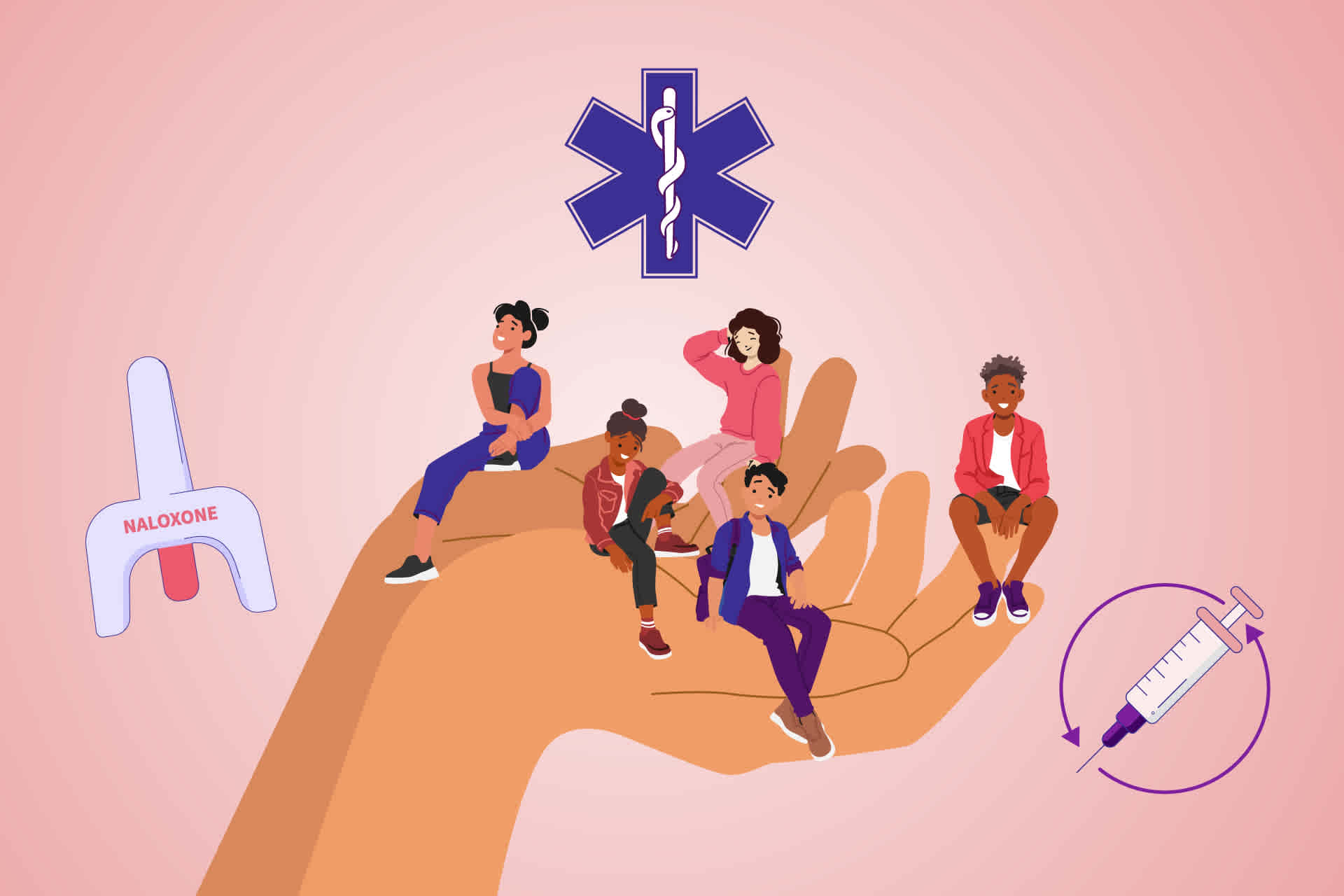Learn / Exploring Harm Reduction: Strategies and Benefits in Substance Use
Exploring Harm Reduction: Strategies and Benefits in Substance Use


April 16th, 2024| Clinically Reviewed by
Key Points
- Harm reduction is a set of strategies aimed at minimizing the risks of substance use.
- Its destigmatizing approach focuses on treating everyone with dignity and respect.
- It’s not a replacement for abstinence, but encourages “any positive change.”
Harm reduction is not about abstinence. It’s a practical and evolving set of strategies aimed at minimizing the risks of substance use. As opposed to abstinence-only frameworks like 12-Step, harm reduction recognizes that abstinence isn’t always achievable, or the sole indicator of well-being.
In a country where overdose deaths reached a staggering 106,6991 in 2021, it’s clear that we need a different approach. While not a replacement for abstinence, harm reduction offers a pragmatic and lifesaving set of strategies.
We’ll examine the various harm reduction strategies available, the benefits they offer, and how they play a crucial role in supporting people and communities on the path to a better life.
The Principles of Harm Reduction: Any Positive Change
Core Values and Ethics
Harm reduction practices emerged from activist communities of color2 in the ‘60s, ‘70s, and ‘80s. These advocates were looking for alternative approaches to protect their communities from being disproportionately affected by problems like HIV and addiction. Over the years, these threads came together to form a movement.
Harm reduction operates on the principle of respect and dignity for all, providing safe, supportive spaces where people can access services without fear of being judged or punished. By acknowledging people’s current reality rather than imposing idealized expectations, the harm reduction approach aims to meet people where they are. The Chicago Recovery Alliance states its mission as providing people in their community living with HIV and drug use “with a wide array of options for achieving any positive change as they define it for themselves.”3
This means offering practical tools and strategies for safer use, alongside support for those seeking abstinence or other paths to recovery. It’s about empowering people to make informed choices and reduce the risks associated with substance use,4 including incarceration. “Our work remains important today because the United States continues to arrest people for using drugs,” says Joyce Rivera of the National Harm Reduction Coalition (NHRC).
Goals and Objectives
Harm reduction takes a multi-pronged approach to reduce the negative consequences of drug use.
- Protecting health: Harm reduction programs provide access to sterile syringes, overdose reversal medication (like naloxone), and education on safer use practices to prevent infections, overdoses, and other health risks.
- Minimizing social harms: By addressing the root causes of drug use and offering support services, harm reduction programs aim to decrease criminal activity, homelessness, and family disruption often caused by drug use.
- Reducing legal consequences: Harm reduction groups advocate for policies that prioritize treatment and support over criminal punishment.
The Substance Abuse and Mental Health Services Administration outlines 6 pillars of harm reduction:5
- The work is led by people with lived experience of substance use.
- All people are treated with dignity and respect.
- Efforts are built on community engagement and community building.
- Practices are informed by an awareness of human rights, equity, and social justice.
- Support is accessible and noncoercive.
- Initiatives focus on any positive change.
It’s Not Just for Substance Use
It should also be noted that harm reduction doesn’t just apply to drug use.
The National Health Care for the Homeless Council defines the harm reduction approach:6
“Harm reduction utilizes a spectrum of strategies to reduce the negative consequences associated with drug use, sex work, and other behaviors.”
These strategies include safer techniques, managed use, and abstinence, and can be applied to any potentially harmful behaviors, such as eating disorders.
Strategies and Practices in Harm Reduction
Needle and Syringe Programs (NSPs)
A cornerstone of harm reduction strategies is needle and syringe programs,7 or NSPs. These programs provide sterile syringes and injection equipment to people who inject drugs (PWID). This simple intervention plays a major role in preventing the spread of bloodborne diseases like HIV and hepatitis C.
NSPs operate by distributing clean syringes in exchange for used ones. They also offer education on safer injection practices, disposal of used syringes, and access to other health services. Studies consistently show that NSPs effectively decrease HIV and hepatitis C transmission rates8 among PWID.
Medication-Assisted Treatment (MAT)
Harm reduction embraces medication-assisted treatment (MAT) as a tool to reduce risks and improve health outcomes. MAT uses prescription opioids like methadone or buprenorphine to replace illicit opioids. Patients taper off of these medications, or adjust their dosage, according to a treatment plan administered under medical supervision. This allows them to manage their substance use, focus on stabilizing their lives, and improve mental and physical health while pursuing their recovery goals.
MAT is proven effective in reducing overdose deaths,9 preventing risky behaviors like needle sharing, and promoting retention in treatment programs. It carries its own risks, and it’s not for everyone. But for some, MAT is a necessary starting point for rebuilding their lives.
Safe Consumption Sites
Safe consumption sites (SCSs), also known as overdose prevention centers,10 are controlled spaces where people use pre-obtained substances under trained medical supervision.
These facilities provide sterile injecting equipment, harm reduction education, and access to naloxone to reverse overdoses. The presence of medical staff allows for immediate intervention in case of overdose, dramatically increasing the chances of survival. SCSs also connect people seeking recovery with addiction treatment services and social support programs.
Research shows that SCSs reduce overdose deaths and do not increase crime or drug use11 in surrounding areas. These facilities aim to save lives by creating a safer environment for people who already use substances.
Explore Drug Addiction Treatment Centers
Naloxone Distribution
In the U.S., a person dies from a drug overdose every 5 minutes.12 As substances like fentanyl further exacerbate the opioid crisis, that number continues to rise.
Harm reduction programs promote the widespread distribution of naloxone, a medication that reverses opioid overdoses. Studies show a clear correlation between increased naloxone distribution and reduced overdose deaths.13 By equipping more communities with this tool, harm reduction programs empower people to take action and save lives.
Evidence and Impact of Harm Reduction
Scientific research overwhelmingly supports the effectiveness of harm reduction strategies. Studies consistently show that programs like NSPs and naloxone distribution reduce HIV and hepatitis C transmission rates, as well as overdose deaths, among people who use drugs. According to one peer-reviewed study on safe consumption facilities,14
“Findings indicate that SCFs were associated with reducing drug use related infection and disease transmission, enhancing access to addiction and other health services, reducing the risk of non-fatal overdoses, and were not associated with a significant increase in drug use, or an increased rate of drug-related crime.”
“Addiction is cruel enough, I assure you.”
Morgan Godvin credits harm reduction with saving her life.15 After a hepatitis C exposure, she walked into a needle exchange, feeling scared and alone. But what she found was nonjudgmental support.
“Harm reduction is not at odds with treatment. But it is the one, single space where I could just be. Where I wasn’t being bombarded with signals about how bad I was, how I needed to change. As if I didn’t already know. As if I hadn’t already tried…I’d found, finally, one single safe space in all the world. A refuge.”
That safe space supported Godwin until she was able to recover, and she now works as a harm reduction advocate.
Harm reduction offers a compassionate alternative to legal and societal approaches that tend to shame drug users. “Harm reductionists were kind to me when no one else was, least of whom myself. There was no prodding or coercion, only compassion,” says Godwin. “Addiction is cruel enough, I assure you.”
“Harm reduction is compassion.”
Another woman, Louise, believes harm reduction and destigmatized education could have helped her throughout her struggles with drug abuse.16
“I didn’t set out for this, and I wouldn’t wish it on anybody. The fact that we harm people even more when they’re in these vulnerable places and in these places where they desperately need love and they desperately need human compassion and empathy is unforgivable.”
She also blames a lack of harm reduction tools and mental health awareness for her daughter’s drug-related death after she was admitted to rehab:
“The rehab she went to did not have Naloxone on-site. They obviously did not take dual diagnosis serious, even though I talked to them for hours about the importance of a treatment center that actually took her mental illness serious. No Naloxone… no real understanding of mental illness. Now my daughter who was safer at home with me is no longer here. She was my reason for living.”
Challenges and Controversies Surrounding Harm Reduction
Harm reduction faces significant controversies as critics insist that these programs enable drug use. Ethical debates arise around the concept of meeting people where they are, with some expressing concern that this condones drug use.
One reason MAT programs are controversial is because they use opioid medications in treatment. Keith Humphreys, an addiction researcher at Stanford University, offers this critique of harm reduction:17
“When you start distributing opioids in the community, including to people to stop overdose, they will, in some cases, sell them and initiate new people onto drugs. And those people will overdose. If you just say, we’re just going to supply these drugs, like, what is the end game?”
Many people view these programs as attracting drug use to surrounding neighborhoods, and that perception can block harm reduction efforts. “It’s explosive for politicians and still very controversial ethically among people in the medical community,” says NPR addiction correspondent Brian Mann. Political resistance and cultural stigma around drug use often impede policy changes that lead to wider adoption of harm reduction strategies.
But the wider professional community largely supports harm reduction as an evidence-backed public health strategy. One report in the Drug and Alcohol Review journal warns against creating policy based on assumptions:18
“Despite evidence for their effectiveness, harm reduction services such as needle and syringe programmes (NSPs) are highly vulnerable to perceptions of community disapproval…The main finding of this literature review is that community perceptions of NSPs are largely positive. Also, support for NSPs was not synonymous with condoning drug use.”
Research shows no increase in drug use as a result of harm reduction, but rather a reduction in associated harms.
Global Perspectives on Harm Reduction
Harm reduction strategies take diverse forms across the globe. While countries like Portugal and Switzerland have been successful with harm reduction programs19 including needle exchange programs, safe consumption spaces, and MAT, many regions still face significant barriers. In some nations, like parts of Africa and Asia, strong social stigma and restrictive drug laws impede the implementation of even basic harm reduction interventions. This leads to higher rates of HIV and overdose deaths. According to UNAIDS,
“Amid the widespread stigma and discrimination, violence and poor health faced by people who use drugs,20 people who inject drugs are beset by persistently high rates of HIV…Viral hepatitis and tuberculosis rates among people who use drugs also are high in many parts of the world. These preventable and treatable diseases, combined with overdose deaths that are equally preventable, are claiming hundreds of thousands of lives each year. This is a problem that has a clear solution: harm reduction.”
International organizations like the World Health Organization (WHO) also support harm reduction efforts21 in regions across the world. The Open Society Foundations “advocate for policies that advance the health and human rights of people who use drugs,”22 including access to naloxone and MAT, and harm reduction education.
The global response to substance use requires a coordinated effort that includes sharing best practices, advocating for increased funding, and overcoming cultural and political barriers.
How to Support Harm Reduction Efforts
For Individuals
There are plenty of ways to get involved in harm reduction efforts in your community:
- Educate yourself by researching local harm reduction organizations and their initiatives.
- Spread awareness. Talk openly about harm reduction with friends and family, and challenge negative stereotypes.
- Volunteer at a harm reduction organization. Many organizations welcome volunteers to help with administrative tasks, outreach programs, or fundraising events.
- Advocate for harm reduction policies by contacting your local representatives and urging them to support programs like naloxone distribution and increased access to MAT.
- Donate to organizations working on the frontlines of harm reduction.
For Professionals
Healthcare providers, educators, and other professionals have a unique opportunity to raise awareness around harm reduction. Clinicians can integrate harm reduction into their practice by offering non-judgmental support, discussing safer use practices, and advocating for increased access to services like MAT and naloxone.
Educators play an important role in normalizing conversations about substance use and promoting harm reduction awareness. Educating young people about harm reduction equips them with the knowledge and skills to make informed choices, reduce risks, and be positive influences in their community.
By working collaboratively, professionals across sectors can create a more supportive environment for people with drug-associated risks, empowering others to reach their full potential and fostering healthier communities.
Building a Healthier Tomorrow, Together
Harm reduction offers a lifeline to those who aren’t yet ready for abstinence, and often supports people in getting onto their path toward recovery. By prioritizing safety, public health, and individual well-being, harm reduction strategies reduce negative consequences for our communities. From easy-access tools like naloxone to comprehensive programs like safe consumption spaces, harm reduction saves lives.
Through education, advocacy, and community engagement, we can expand access to harm reduction services and create a culture where everyone is treated with respect, regardless of what they’re going through.
As Monique Tula of the NHRC says, “We will honor our ancestors, hold space for each other, and make way for a new generation.”
-
Drug Overdose Deaths | Drug Overdose | CDC Injury Center. 22 Aug. 2023, https://www.cdc.gov/drugoverdose/deaths/index.html.
-
“Evolution of Harm Reduction.” National Harm Reduction Coalition, https://harmreduction.org/movement/evolution/. Accessed 21 Mar. 2024.
-
Chicago Recovery Alliance, 25 Aug. 2023, https://anypositivechange.org.
-
“Evolution of Harm Reduction.” National Harm Reduction Coalition, https://harmreduction.org/movement/evolution/. Accessed 21 Mar. 2024.
-
Substance Abuse and Mental Health Services Administration: Harm Reduction Framework. Center for Substance Abuse Prevention, Substance Abuse and Mental Health Services Administration, 2023.
-
Tanagra Melgarejo, MSW. “Foundations + History of Harm Reduction.” National Harm Reduction Coalition. https://nhchc.org/wp-content/uploads/2023/06/NHCH_History-Foundations-of-HR-.pdf
-
Strike, Carol, et al. “Guidelines for Better Harm Reduction: Evaluating Implementation of Best Practice Recommendations for Needle and Syringe Programs (NSPs).” International Journal of Drug Policy, vol. 22, no. 1, Jan. 2011, pp. 34–40. ScienceDirect, https://doi.org/10.1016/j.drugpo.2010.03.007.
-
Abdul-Quader AS, Feelemyer J, Modi S, Stein ES, Briceno A, Semaan S, Horvath T, Kennedy GE, Des Jarlais DC. Effectiveness of structural-level needle/syringe programs to reduce HCV and HIV infection among people who inject drugs: a systematic review. AIDS Behav. 2013 Nov;17(9):2878-92. doi: 10.1007/s10461-013-0593-y. PMID: 23975473; PMCID: PMC6509353.
-
Abdul-Quader AS, Feelemyer J, Modi S, Stein ES, Briceno A, Semaan S, Horvath T, Kennedy GE, Des Jarlais DC. Effectiveness of structural-level needle/syringe programs to reduce HCV and HIV infection among people who inject drugs: a systematic review. AIDS Behav. 2013 Nov;17(9):2878-92. doi: 10.1007/s10461-013-0593-y. PMID: 23975473; PMCID: PMC6509353.
-
NIDA. 2023, August 28. Overdose Prevention Centers. Retrieved from https://nida.nih.gov/research-topics/overdose-prevention-centers on 2024, March 21
-
Dow-Fleisner, Sarah J., et al. “Impact of Safe Consumption Facilities on Individual and Community Outcomes: A Scoping Review of the Past Decade of Research.” Emerging Trends in Drugs, Addictions, and Health, vol. 2, Jan. 2022, p. 100046. ScienceDirect, https://doi.org/10.1016/j.etdah.2022.100046.
-
“Every 5 Minutes a Person Dies of Drug Overdose. This Must End.” American Medical Association, 31 Mar. 2023, https://www.ama-assn.org/delivering-care/overdose-epidemic/every-5-minutes-person-dies-drug-overdose-must-end.
-
Naumann, Rebecca B., et al. “Impact of a Community-Based Naloxone Distribution Program on Opioid Overdose Death Rates.” Drug and Alcohol Dependence, vol. 204, Nov. 2019, p. 107536. ScienceDirect, https://doi.org/10.1016/j.drugalcdep.2019.06.038.
-
Dow-Fleisner, Sarah J., et al. “Impact of Safe Consumption Facilities on Individual and Community Outcomes: A Scoping Review of the Past Decade of Research.” Emerging Trends in Drugs, Addictions, and Health, vol. 2, Jan. 2022, p. 100046. ScienceDirect, https://doi.org/10.1016/j.etdah.2022.100046.
-
Coalition, National Harm Reduction. “‘Harm Reduction Saved My Life’ by Morgan Godvin.” National Harm Reduction Coalition, 25 Oct. 2022, https://harmreduction.org/blog/morgan-godvin/.
-
Michels, Jonathan. “Harm Reduction Is Compassion, Harm Reduction Is Love: Louise’s Story.” Scalawag, 14 May 2017, http://scalawagmagazine.org/2017/05/harm-reduction-is-compassion/.
-
Martin, Rachel, and Brian Mann. “Controversial Harm Reduction Strategies Appear to Slow Drug Deaths.” NPR, 15 Sept. 2022. NPR, https://www.npr.org/2022/09/15/1123108839/controversial-harm-reduction-strategies-appear-to-slow-drug-deaths.
-
TRELOAR, C. and FRASER, S. (2007), Public opinion on needle and syringe programmes: avoiding assumptions for policy and practice. Drug and Alcohol Review, 26: 355-361. https://doi.org/10.1080/09595230701373867
-
“HARM REDUCTION SERVICES IN SWITZERLAND.” Harm Reduction International. https://hri.global/wp-content/uploads/2022/11/Harm-Reduction-in-Switzerland_FINAL.pdf
-
“HEALTH, RIGHTS AND DRUGS HARM REDUCTION: DECRIMINALIZATION AND ZERO DISCRIMINATION FOR PEOPLE WHO USE DRUGS.” UNAIDS. https://www.unaids.org/sites/default/files/media_asset/JC2954_UNAIDS_drugs_report_2019_en.pdf
-
“Drug-Related Harm Reduction.” World Health Organization - Regional Office for the Eastern Mediterranean, http://www.emro.who.int/asd/health-topics/drug-related-harm-reduction.html. Accessed 21 Mar. 2024.
-
Harm Reduction. https://www.opensocietyfoundations.org/voices/topics/harm-reduction. Accessed 21 Mar. 2024.
Return to Resource Library
Our Promise
How Is RehabPath Different?
We believe everyone deserves access to accurate, unbiased information about mental health and addiction. That’s why we have a comprehensive set of treatment providers and don't charge for inclusion. Any center that meets our criteria can list for free. We do not and have never accepted fees for referring someone to a particular center. Providers who advertise with us must be verified by our Research Team and we clearly mark their status as advertisers.


















